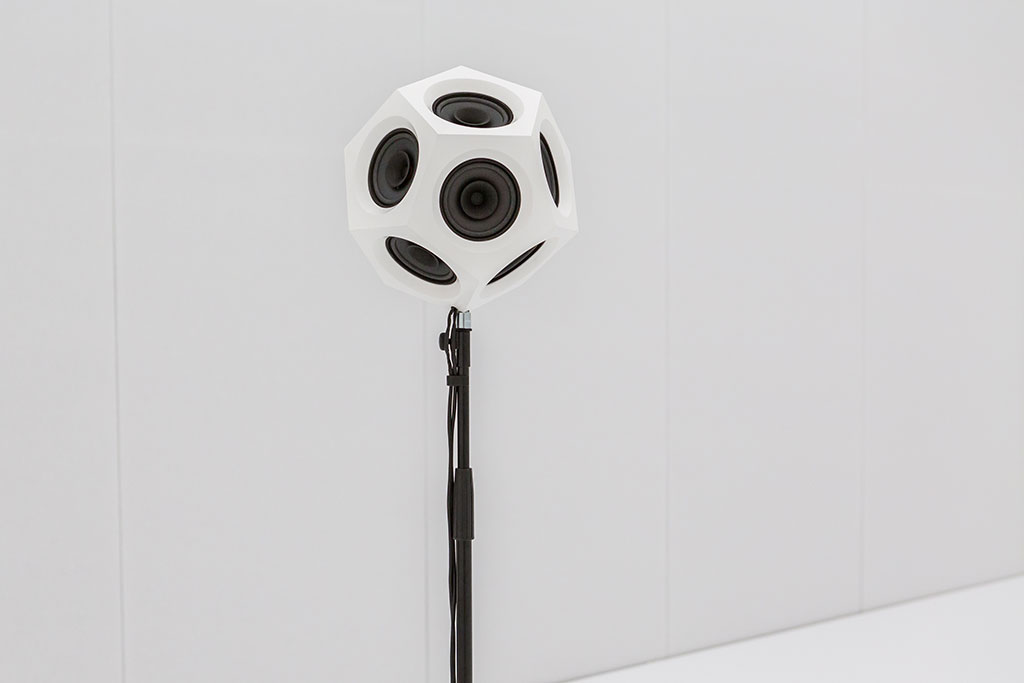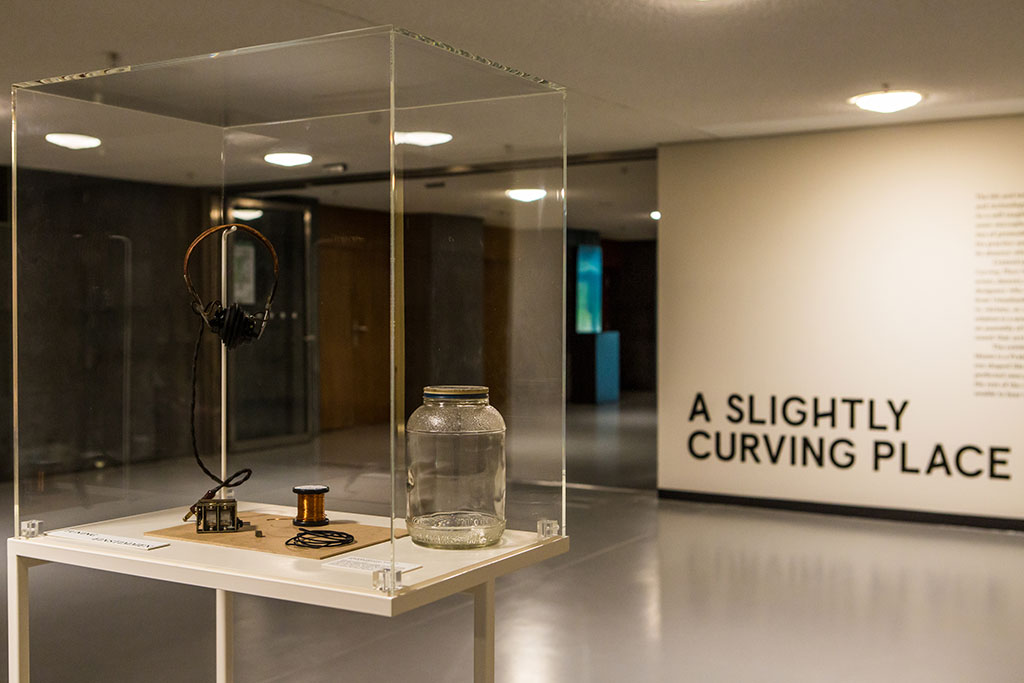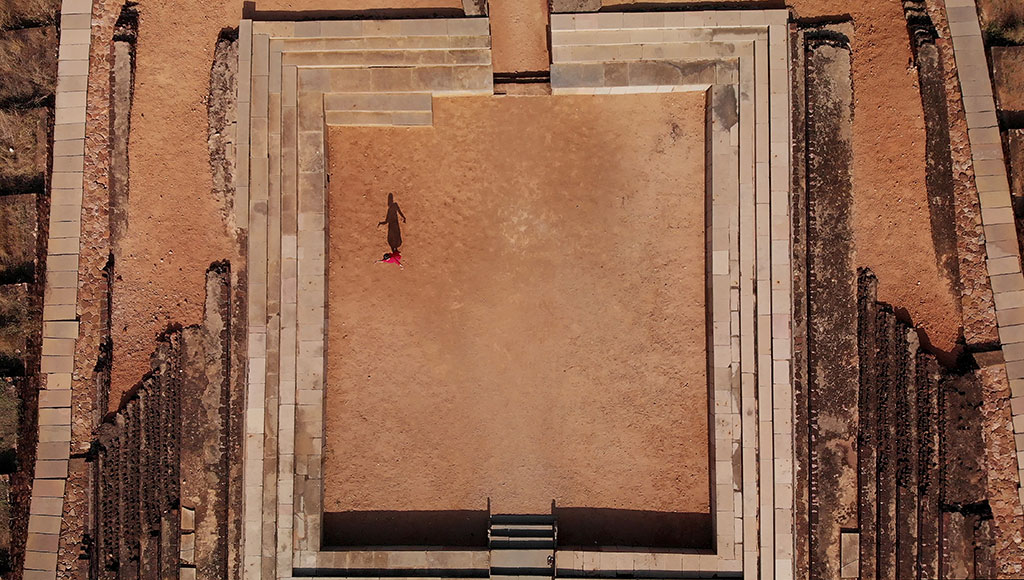ART-PRESENTATION:A Slightly Curving Place
 The exhibition “A Slightly Curving Place” derives its title from a Prakrit* phrase in Jain cosmology**: “Isipabbharabhumi” refers to a special place above the heavens shaped like a parasol where the disembodied souls of the perfected ones go to live in eternal isolation. Sealed off from the rest of the cosmos, they are unable to interact with other souls, unable to hear them or be heard. In this exhibition, a slightly curving place is to be found not at the apex of the universe but under an ambisonic dome of speakers.
The exhibition “A Slightly Curving Place” derives its title from a Prakrit* phrase in Jain cosmology**: “Isipabbharabhumi” refers to a special place above the heavens shaped like a parasol where the disembodied souls of the perfected ones go to live in eternal isolation. Sealed off from the rest of the cosmos, they are unable to interact with other souls, unable to hear them or be heard. In this exhibition, a slightly curving place is to be found not at the apex of the universe but under an ambisonic dome of speakers.
By Dimitris Lempesis
Photo: Haus der Kulturen der Welt Archive
“A Slightly Curving Place” responds to Umashankar Manthravadi, a self-taught acoustic archaeologist who has been building ambisonic microphones to map and measure the acoustic properties of premodern sites of ritual and festival. He proposes that we can’t just look for theaters in landscapes of the past, we must listen for them. Centered around a multi-authored audio play and a video installation, the exhibition brings together writers, choreographers, dancers, actors, composers, musicians, field recordists and sound designers who engage and transform not just each other’s work but also that of many others. Audio play: “A Slightly Curving Place”: One use of an ambisonic microphone is to measure the acoustic properties of a space, to consider its potential for performance, for instance. What could be done with such a measurement? In principle— insofar as the mythology of technology goes—a dry studio recording can be processed to sound as if it were resonating in that specific location. This audio play takes up Umashankar’s practice of listening to premodern performance spaces and stages itself as an exhibition (within an exhibition). Generated through a series of relays between script and voice and sound and movement, it extends the notion of an archaeological site to include text and technologies and the fields of recording. Writers produced narrative and conceptual scripts. Performers performed them. Sound designers approached the recorded material through their various understandings of sound as matter, meaning, and music. With each, a defined location emerges with no visible boundaries present. Video installation: “A Slightly Curving Place – A Study 2020”: This is a study towards a film for six dancers. It is composed of footage from a research visit to a transplanted archaeological site in Anupu. Shot tentatively early one morning and the next evening, it is a discovering of light: its directions, its qualities, what it does to the textures and shadows of the space. It is a study of volume and proportion: a single body lost in scale to the vast landscape or filling the frame to propose itself. It is also a thinking about perspective: the image of a dancer’s body moving in a space and the movement of a dancer’s body making an image, in conversation. It is a study of how to frame space, how to bring different temporalities—ancient and contemporary—onto the same plane, how to evoke history without narrating it. The images are heard through a score that asks us to listen to the textures of a potentially unravelling time and timelessness—a slightly curving place.
* The Prakrits are a group of vernacular Middle Indo-Aryan languages used in India from around the 3rd century BCE to the 8th century CE. The term Prakrit is usually applied to the middle period of Middle Indo-Aryan languages, excluding earlier inscriptions and the later Pali. The Prakrits were used contemporaneously with the prestigious Classical Sanskrit of higher social classes.
The exhibition is realized in collaboration with and with contributions by: Umashankar Manthravadi, Bani Abidi, Mojisola Adebayo, Vinit Agarwal, Sukhesh Arora, Anurima Banerji, Lilia Di Bella, Moushumi Bhowmik, Arunima Chatterjee, Madhuri Chattopadyay, Padmini Chettur, Emese Csornai, Padma Damodaran, Hugo Esquinca, Jenifer Evans, Eunice Fong, Tyler Friedman, Janardan Ghosh, Brooke Holmes, Alexander Keefe, Sukanta Majumdar, Robert Millis, Farah Mulla, Rita Sonal Panjatan, Ayaz Pasha, TJ Rehmi, RENU, Uzma Z. Rizvi, Sara, Yashas Shetty, The Travelling Archive and Maarten Visser.
** Jain cosmology is the description of the shape and functioning of the Universe (loka) and its constituents (such as living beings, matter, space, time etc.) according to Jainism. Jain cosmology considers the universe as an uncreated entity that has existed since infinity with neither beginning nor end. Jain texts describe the shape of the universe as similar to a man standing with legs apart and arm resting on his waist.
Info: Curator: Nida Ghouse, Haus der Kulturen der Welt (HKW), John-Foster-Dulles-Allee 10, Berlin, Duration: 23/7-20/9/20, Days & Hours: Mon & Wed-Sun 14:00-20:00, www.hkw.de




